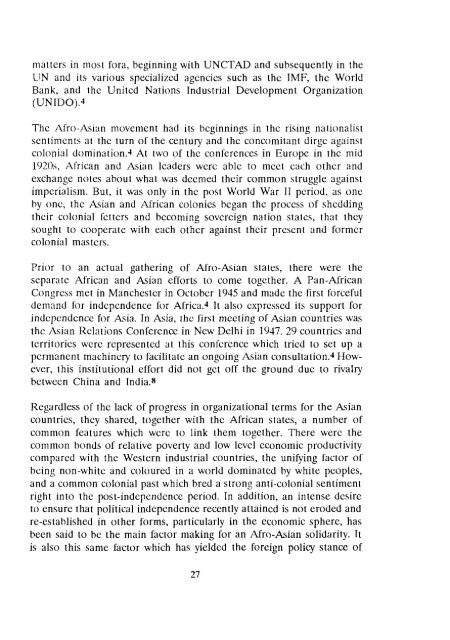ifda dossier 74 - Dag Hammarskjöld Foundation
ifda dossier 74 - Dag Hammarskjöld Foundation
ifda dossier 74 - Dag Hammarskjöld Foundation
Create successful ePaper yourself
Turn your PDF publications into a flip-book with our unique Google optimized e-Paper software.
matters in most fora, beginning with UNCTAD and subsequently in the<br />
UN and its various specialized agencies such as the IMF, the World<br />
Bank, and the United Nations Industrial Development Organization<br />
(UNIDO).4<br />
The Afro-Asian movement had its beginnings in the rising nationalist<br />
sentiments at the turn of the century and the concomitant dirge against<br />
colonial domination.4 At two of the conferences in Europe in the mid<br />
1920s, African and Asian leaders were able to meet each other and<br />
exchange notes about what was deemed their common struggle against<br />
imperialism. But, it was only in the post World War I1 period, as one<br />
by one, the Asian and African colonies began the process of shedding<br />
their colonial fetters and becoming sovereign nation states, that they<br />
sought to cooperate with each other against their present and former<br />
colonial masters.<br />
Prior to an actual gathering of Afro-Asian states, there were the<br />
separate African and Asian efforts to come together. A Pan-African<br />
Con~ress met in Manchester in October 1945 and made the first forceful<br />
demand for independence for Africa.4 It also expressed its support for<br />
independence for Asia. In Asia, the first meeting of Asian countries was<br />
the Asian Relations Conference in New Delhi in 1947. 29 countries and<br />
territories were represented at this conference which tried to set up a<br />
permanent machinery to facilitate an ongoing Asian consultation.4 However,<br />
this institutional effort did not get off the ground due to rivalry<br />
between China and India.8<br />
Regardless of the lack of progress in organizational terms for the Asian<br />
countries, they shared, together with the African states, a number of<br />
common features which were to link them together. There were the<br />
common bonds of relative poverty and low level economic productivity<br />
compared with the Western industrial countries, the unifying factor of<br />
being non-white and coloured in a world dominated by white peoples,<br />
and a common colonial past which bred a strong anti-colonial sentiment<br />
right into the post-independence period. In addition, an intense desire<br />
to ensure that political independence recently attained is not eroded and<br />
re-established in other forms, particularly in the economic sphere, has<br />
been said to be the main factor making for an Afro-Asian solidarity. It<br />
is also this same factor which has yielded the foreign policy stance of
















